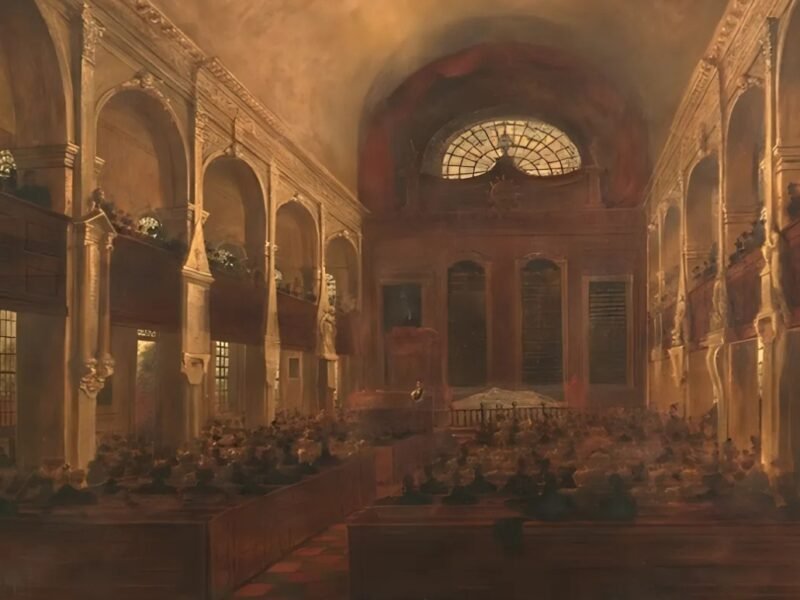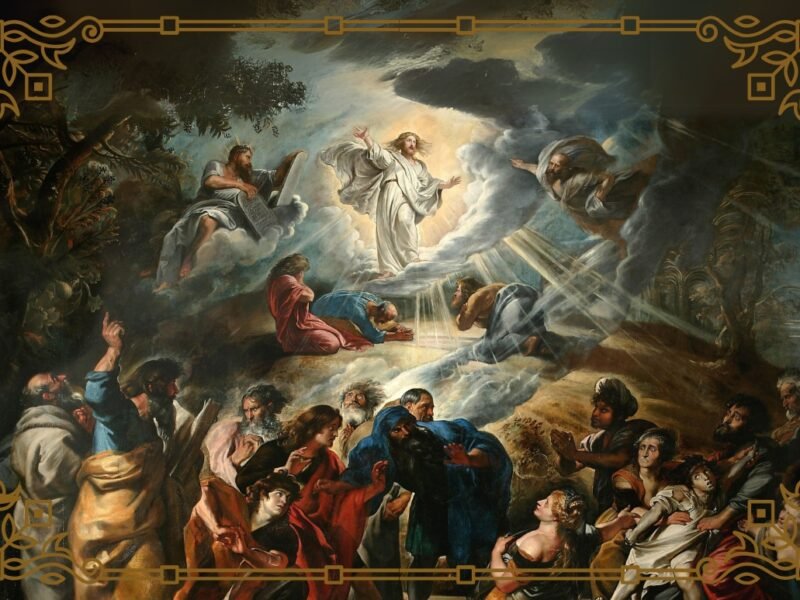“Among the surviving wills it has been found that 45 per cent of testators in fifteenth-century Norwich made such a provision [leaving a bequest to a monastery]. In London it was 36 per cent, and in York about 33 per cent.”[1]
The quotation above, when I first read it in Volume III of Kenneth-Hylson-Smith’s Christianity in England from Roman Times to the Reformation, made me sit up from my slouching reading posture, take out the red pen by which I pour out my life’s blood into the books I live with, and mark this passage for meditation.
You may remember that when I published Tract VI, “The Idea of the Anglican University,” I wrote:
To make such a dream come true will, of course, require money. The obligation placed upon us by the fact that we live in an unprecedented era of wealth creation has impressed itself upon me with increasingly greater clarity and urgency. Every week we hear about how poorly Americans are supposedly doing financially, and we do, indeed, still have the poor among us. As I write this, we are also experiencing what is for most of us an unprecedented period of job loss, which, I pray, will be very temporary.
But the fact remains that many Americans are wealthy. If we honestly examined our hearts and our habits and took a sober reckoning of our spending, we would see that many of us have much more discretionary income than we think we have. The problem is that we’ve frittered much of it away on luxuries and extravagances for ourselves.
Many of us will die with considerable sums of money, which we should happily give to our children. But some of that wealth should go to the church as well, not only the local parish but also seminaries, parochial schools, and, if we ever create them, Anglican universities.
I stand by what I wrote, except that now I wish to magnify it. I want to ask and answer the question: “How can we build cathedrals in the modern age?” I’m using cathedrals not as the literal focus of this essay but as a symbol of the Church’s need to build her ecclesiastical institutions: cathedrals, monasteries, local parishes, seminaries, Christian colleges, and parochial schools. For the medieval cathedral is the summit of Christian architecture and Christian giving to the Church, and cathedrals continue to inspire us today.
How did the great cathedrals of Europe get built, in a time when the world was much less wealthy and the collective wealth of Christians much less? Medieval Christians, on average far poorer than American Christians today, were able to afford to build the great cathedrals of Europe, as well as innumerable monastic houses and parish churches, because the wealthy gave a much larger proportion of their wealth to the Church than wealthy Christians today (who are much more numerous).
From the time of Gallienus’ edict of toleration in 260, Christians began to leave money and land to the Church. In Asia Minor and Syria by the end of the fourth century 1/3 of property was left to the Church. In the West, it was common to leave the Church the share that would be given to an additional child.[2] Both of these schemes seem proper for Christians to consider today. In the early Middle Ages, 1/3 to ½ of land in most villages was donated to churches and monasteries.[3] These generous bequests allowed the Carolingian Church to penetrate much deeper and further than would otherwise have been possible.
What about today? Most of us don’t think of ourselves as wealthy. But if you’re one of the millions of Americans who will die with hundreds of thousands of dollars in your estate (or even more than a million): you’re wealthy. Not Bill Gates-Elon Musk-Jeff Bezos rich, but still rich. We have met the rich, and they are us.
First, let me establish the point that although many Americans are in debt, we are living in an unprecedented age of wealth creation. One article states that over the next 25-30 years, 36 trillion dollars will flow from one generation to the next.[4] Another study shows that the average American leaves behind a net worth of approximately $300,000.[5] Many of those who will be leaving this money to others are Christians.
What will we do with the money God has given us to leave to others?
Christians have largely assumed that their inheritance should almost entirely go to their children. Certainly, leaving our children an inheritance is a godly endeavor. But how many of us have considered how much of our estate should go to the Church?
It’s a question that demands to be asked and answered
According to one report, only about 5-7% of estates contain a charitable bequest. Of these, church/spiritual bequests make up 27% of the total cash amount given out in charitable bequests, while community bequests are 17% and animal bequests 16% (yes, that’s right, animal bequests aren’t far behind church/spiritual bequests). The average bequest to church/spiritual entities: $10,000. [6] Is this the best we can do?
Perhaps one of the reasons Christians leave so little to the Church is that we don’t fully believe that the Church is the Mystical Body of Christ but instead believe it is more of a voluntary association of individual Christians. Also, we think of ourselves primarily in terms of the nuclear family, to the exclusion of all else. When we think of who we are, our first impulse is often to define ourselves in terms of ourselves as autonomous individuals, and then in terms of nuclear and extended families, but not in terms of the Church. But the Church is the family of families. Each Christian family is a part of this larger divine family, a divine family which ought not to be left out of estate planning.
Are we to imagine that all of the wealth we’ve accumulated in recent decades was by the strength of our arms or the hugeness of our brains? All of it is God’s, and He’s given it to us as a unique stewardship. Leaving all of our money to our kids seems still too focused on self, for our children, in a very real way, are extensions of ourselves.
Don’t get me wrong: I intend to leave each of my six children an equal share of the vast hoard I’ve accumulated by working in private Christian schools and working in Reformed Episcopal parishes. But I’ve also revised my will so that a significant portion of my estate will go directly to the Church.
I’ll give you just one personal example of what can be done. For eight years, after we outgrew our original sanctuary which held 100 people, Good Shepherd Reformed Episcopal Church made plans and raised funds to build a much-needed new sanctuary. The parish continued to grow, even as it met in our gym, transformed each week into a sanctuary, until we have now reached almost 200 members. Still no new building.
But when one of our parishioners died more than a year ago, we discovered that she and her deceased husband had left Good Shepherd Church and Good Shepherd School a substantial sum, the residue of the estate which had been largely left to the children. What this means is that Good Shepherd can now proceed with her plans to build a traditional Anglican church that will hold 250 members and will last for centuries.
Our parishes may not have such saints who will leave a large part of their estate to the Church, but I’m fairly certain we have many parishioners who could leave a substantial bequest to the Church, if they were inspired to do so.
Now is the time. It’s no longer news to most of us that dark days are coming for Christians, and, perhaps, a New Dark Age. As William Butler Yeats wrote:
Things fall apart; the centre cannot hold;
Mere anarchy is loosed upon the world,
The blood-dimmed tide is loosed, and everywhere
The ceremony of innocence is drowned;
The best lack all conviction, while the worst
Are full of passionate intensity.
The darkness drops again; but now I know
That twenty centuries of stony sleep
Were vexed to nightmare by a rocking cradle,
And what rough beast, its hour come round at last,
Slouches towards Bethlehem to be born?[7]
Churches and other Christian institutions, such as parochial schools, seminaries, and Christian colleges, are likely to lose their tax-exempt status (if they remain faithful to the faith), and Christians are likely to respond by giving less. Churches in Western nations will continue to face financial crises. The Church of England has had increasing problems with funding, and many local parish churches that can no longer be sustained financially have been and are being sold off to private buyers.
With the shaking loose of Christians during COVID (and probably post- COVID), as well as the impending loss of tax-exempt status for churches and religious institutions and other factors, Christians need to begin thinking now about building their churches up to be sustained in the future.
Now is the time to plan to give to the Church, not only our tithe but also part of our estate. We still have time to edify our parishes, dioceses, seminaries, and parochial schools, while we still have a lot to give. We still have time to plant new missions and church works. If we want the Church to be better positioned to withstand the onslaught of secularism, cultural Marxism, Critical Theory, wokeness, and whatever enemies raise themselves against God’s people in the coming decades, then we need to support godly churches and institutions – now. More importantly, if we want the Church to be the visible presence of Christ to the culture that has produced these social movements, we need to build our “cathedrals.”
Even if I’m wrong in my assessment of where Western culture is going, the call for wealthy Christians (which means many of us) to leave some of their wealth to build God’s kingdom by building His churches, stands. Now is the time to build the Christian cathedral, and all of the other ecclesiastical institutions that will disciple the saints and be a light to the world we live in.
- Kenneth-Hylson-Smith’s Christianity in England from Roman Times to the Reformation, p. 104. ↑
- Chadwick, The Early Church, 58. ↑
- Peter Brown, The Rise of Western Christendom, 443. ↑
- https://financialpost.com/personal-finance/baby-boomers-are-thriving-on-an-unprecedented-9-trillion-inheritance. This Forbes article cites the statistic 30 trillion dollars – https://www.forbes.com/sites/markhall/2019/11/11/the-greatest-wealth-transfer-in-history-whats-happening-and-what-are-the-implications/#607305344090. ↑
- https://www.newretirement.com/retirement/average-inheritance-how-much-are-retirees-leaving-to-heirs/ ↑
- https://www.uslegalwills.com/blog/planned-giving/ ↑
- From “The Second Coming.” ↑






'Building Cathedrals in the Modern Age' have 2 comments
April 16, 2021 @ 3:23 am Greg
An excellent essay that deserves to be spread and read widely across the Anglican world! Thank you Fr Charles.
September 17, 2021 @ 1:50 pm Charles Erlandson
Thanks, Greg!